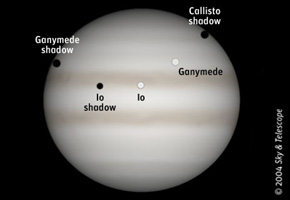I’ve heard it might be possible to detect Jupiter’s satellites with the unaided eye if Callisto and Ganymede appear together when Ganymede is at greatest elongation from Jupiter. Will this happen anytime soon?

Jupiter is now setting soon after sunset. But three times in 2008, Texans (and North Americans generally) will have a chance to see what you’re describing: on March 6th near 5:40 a.m. Central Standard Time, then on October 20th between 8 and 9 p.m. Central Daylight Time, and finally on November 14th near 7:10 p.m. CST.
But don’t get your hopes up. Ganymede is the brightest moon, magnitude 5.3, but it never strays more than 5′ from Jupiter. Callisto, magnitude 6.5, enhances Ganymede’s brightness to just 5.0 (combined). Compare this to Mizar’s naked-eye companion, Alcor, in the Big Dipper’s handle. Alcor is magnitude 4.0 and 11.8′ from Mizar — and they’re often called a test of acuity.
So I doubt Ganymede can ever be seen with the naked eye, with or without Callisto’s help. But they’d be fine targets for an instrument I’ve dreamed of yet never seen in the marketplace: a modern, wide-field binocular with a magnification of just 3× or 4×.
— Roger W. Sinnott
 0
0







Comments
You must be logged in to post a comment.